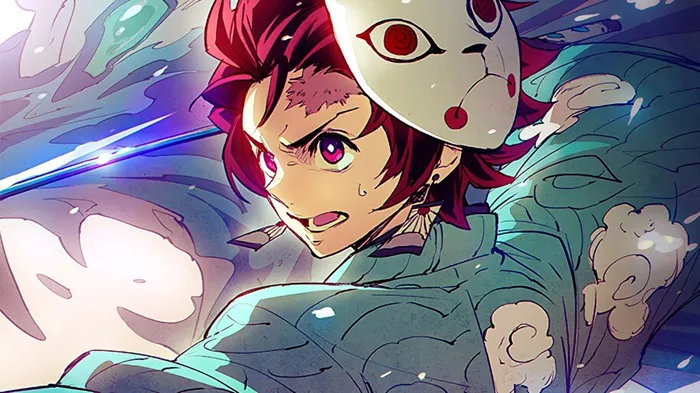In the popular manga and anime series Demon Slayer: Kimetsu no Yaiba by Koyoharu Gotouge, Tanjiro Kamado is the protagonist whose journey to become a demon slayer is both captivating and inspiring. One of the notable aspects of Tanjiro’s character design is the mask he wears during his training and initial battles. This article delves into the significance of Tanjiro’s mask, its name, origin, and symbolism, as well as its impact on his journey as a demon slayer.
Tanjiro Kamado
Character Background
Tanjiro Kamado is a kind-hearted and determined young boy who becomes a demon slayer after his family is slaughtered by demons and his sister, Nezuko, is turned into a demon. His primary goal is to find a cure for Nezuko and avenge his family’s death. Tanjiro’s journey is marked by intense training, fierce battles, and unwavering resolve.
Training to Become a Demon Slayer
Tanjiro’s path to becoming a demon slayer begins under the tutelage of Sakonji Urokodaki, a former Water Hashira (elite demon slayer). During his training, Tanjiro undergoes rigorous physical conditioning, learns swordsmanship, and masters the Water Breathing technique, which is essential for combating demons.
The Significance of Tanjiro’s Mask
Name of the Mask
Tanjiro’s mask is known as the Hanafuda Earrings Mask or simply Hanafuda Mask. While this name is not explicitly stated in the series, it derives from the distinct hanafuda earrings Tanjiro wears, which feature a similar design and carry significant cultural and familial symbolism.
Origin of the Mask
The Hanafuda Mask is crafted and given to Tanjiro by his mentor, Sakonji Urokodaki, upon completing his training. Urokodaki is known for creating these masks for his disciples, each imbued with protective charms and unique designs to symbolize the wearer’s spirit and attributes.
Design and Appearance
The Hanafuda Mask features a fox-like visage with a red-tinted scar across its face, mimicking the one Tanjiro later acquires in his battles. The mask is painted with a serene yet fierce expression, symbolizing the duality of Tanjiro’s compassionate nature and his warrior spirit.
Symbolism of the Hanafuda Mask
Protection and Guidance
The primary purpose of the Hanafuda Mask is to offer protection to its wearer. Urokodaki’s masks are enchanted with a protective charm to safeguard his students from harm during their dangerous missions. The mask acts as a guardian, watching over Tanjiro as he faces perilous encounters with demons.
See Also: shodai kitetsu owner
Legacy and Tradition
The mask signifies Tanjiro’s connection to the lineage of demon slayers trained by Urokodaki. It embodies the legacy of discipline, strength, and resilience passed down through generations. Wearing the mask, Tanjiro honors the tradition and his mentor’s teachings, carrying forward the spirit of his predecessors.
Personal Growth and Transformation
The Hanafuda Mask symbolizes Tanjiro’s personal growth and transformation from a grieving brother to a formidable demon slayer. The scar on the mask mirrors the emotional and physical scars Tanjiro endures, representing his resilience and determination to overcome adversity.
Tanjiro’s Journey with the Hanafuda Mask
Initial Battles and Trials
Tanjiro’s journey as a demon slayer begins with the Final Selection, a grueling test where aspiring demon slayers must survive a week on Mount Fujikasane, a demon-infested area. Wearing the Hanafuda Mask, Tanjiro demonstrates his skills and bravery, earning his place among the demon slayers.
Encounters with Powerful Demons
Throughout the series, Tanjiro faces numerous powerful demons, each battle testing his limits and honing his abilities. The Hanafuda Mask remains a constant presence, reminding Tanjiro of his training and the support of his mentor and comrades.
Evolving Symbolism
As Tanjiro progresses in his journey, the Hanafuda Mask evolves from a symbol of protection to one of inner strength and resilience. Even when the mask is not physically present, its influence is felt in Tanjiro’s unwavering resolve and commitment to his mission.
Cultural and Artistic Significance
Hanafuda Cards and Japanese Culture
The design of the Hanafuda Mask is inspired by traditional Japanese hanafuda cards, which are used in various games and have a rich cultural history. Hanafuda cards feature intricate floral and seasonal designs, symbolizing nature’s beauty and the passage of time. The association with hanafuda cards adds a layer of cultural depth to Tanjiro’s mask, connecting him to Japanese heritage and tradition.
Artistic Representation
The Hanafuda Mask is not only a functional item but also an artistic representation of Tanjiro’s character. Its design reflects the artistry and craftsmanship of Urokodaki, who imbues each mask with personality and symbolism. The mask serves as a visual and thematic element that enhances Tanjiro’s identity as a demon slayer.
Impact on Fans and Popular Culture
Iconic Status
The Hanafuda Mask has become an iconic symbol in Demon Slayer: Kimetsu no Yaiba, widely recognized and beloved by fans. It represents Tanjiro’s courage and the series’ themes of perseverance and hope. The mask’s distinct design has made it a popular element in fan art, cosplay, and merchandise.
Inspiring Resilience
For many fans, Tanjiro’s Hanafuda Mask is a source of inspiration, symbolizing resilience in the face of adversity. It encourages viewers to embrace their struggles and continue fighting for their goals, much like Tanjiro does in his quest to save Nezuko and defeat the demons.
Conclusion
Tanjiro Kamado’s Hanafuda Mask is a significant and multifaceted symbol within Demon Slayer: Kimetsu no Yaiba. It embodies protection, legacy, personal growth, and cultural heritage. As Tanjiro journeys from a grieving brother to a powerful demon slayer, the mask serves as a constant reminder of his mentor’s guidance, the traditions he upholds, and the inner strength he cultivates. Its impact extends beyond the narrative, inspiring fans and becoming a cultural icon in its own right. Through the Hanafuda Mask, Tanjiro’s story resonates with themes of resilience, hope, and the enduring spirit of the human heart.

